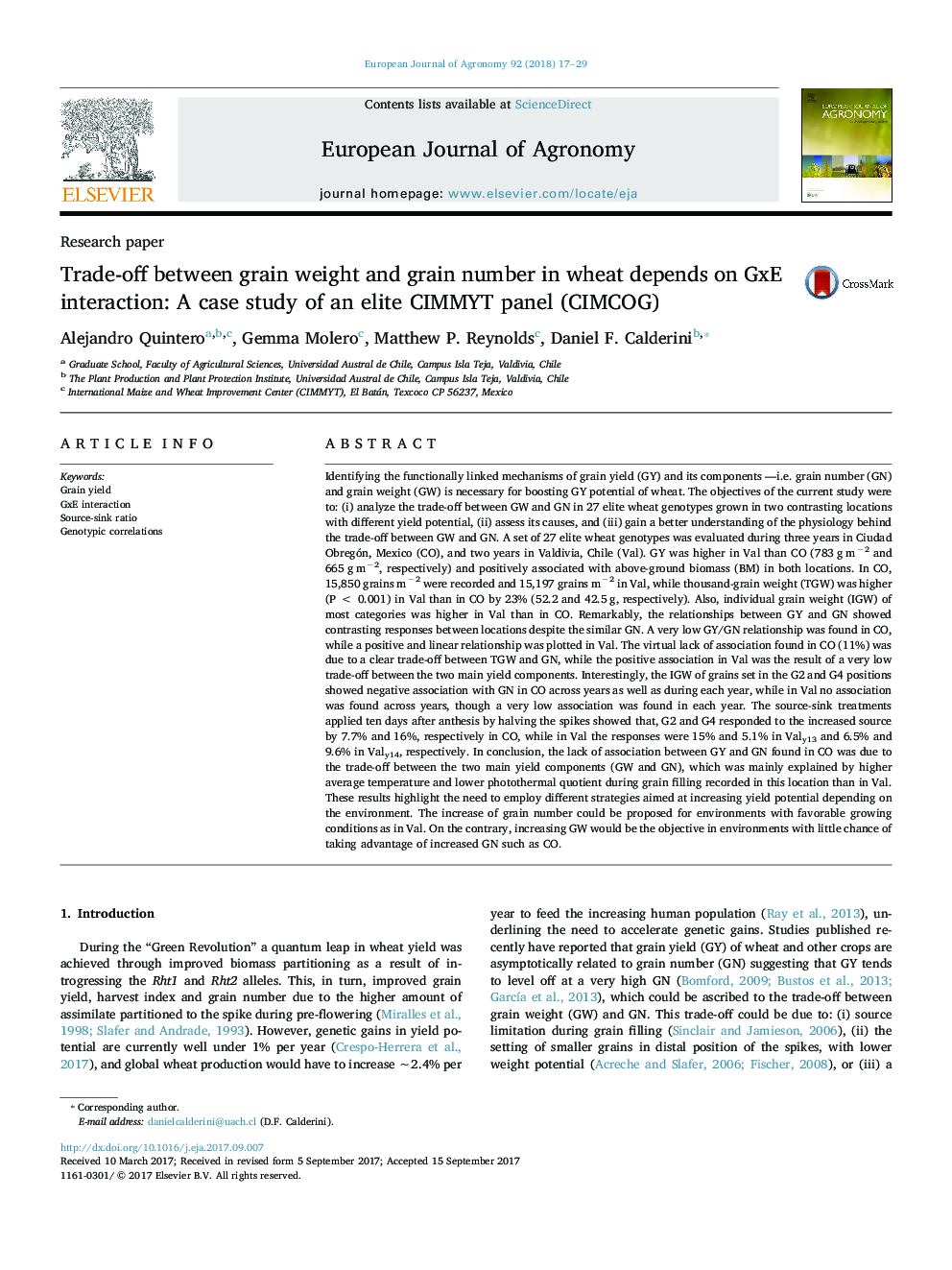| کد مقاله | کد نشریه | سال انتشار | مقاله انگلیسی | نسخه تمام متن |
|---|---|---|---|---|
| 5761201 | 1624432 | 2018 | 13 صفحه PDF | دانلود رایگان |
عنوان انگلیسی مقاله ISI
Trade-off between grain weight and grain number in wheat depends on GxE interaction: A case study of an elite CIMMYT panel (CIMCOG)
دانلود مقاله + سفارش ترجمه
دانلود مقاله ISI انگلیسی
رایگان برای ایرانیان
موضوعات مرتبط
علوم زیستی و بیوفناوری
علوم کشاورزی و بیولوژیک
علوم زراعت و اصلاح نباتات
پیش نمایش صفحه اول مقاله

چکیده انگلیسی
Identifying the functionally linked mechanisms of grain yield (GY) and its components -i.e. grain number (GN) and grain weight (GW) is necessary for boosting GY potential of wheat. The objectives of the current study were to: (i) analyze the trade-off between GW and GN in 27 elite wheat genotypes grown in two contrasting locations with different yield potential, (ii) assess its causes, and (iii) gain a better understanding of the physiology behind the trade-off between GW and GN. A set of 27 elite wheat genotypes was evaluated during three years in Ciudad Obregón, Mexico (CO), and two years in Valdivia, Chile (Val). GY was higher in Val than CO (783 g mâ2 and 665 g mâ2, respectively) and positively associated with above-ground biomass (BM) in both locations. In CO, 15,850 grains mâ2 were recorded and 15,197 grains mâ2 in Val, while thousand-grain weight (TGW) was higher (P < 0.001) in Val than in CO by 23% (52.2 and 42.5 g, respectively). Also, individual grain weight (IGW) of most categories was higher in Val than in CO. Remarkably, the relationships between GY and GN showed contrasting responses between locations despite the similar GN. A very low GY/GN relationship was found in CO, while a positive and linear relationship was plotted in Val. The virtual lack of association found in CO (11%) was due to a clear trade-off between TGW and GN, while the positive association in Val was the result of a very low trade-off between the two main yield components. Interestingly, the IGW of grains set in the G2 and G4 positions showed negative association with GN in CO across years as well as during each year, while in Val no association was found across years, though a very low association was found in each year. The source-sink treatments applied ten days after anthesis by halving the spikes showed that, G2 and G4 responded to the increased source by 7.7% and 16%, respectively in CO, while in Val the responses were 15% and 5.1% in Valy13 and 6.5% and 9.6% in Valy14, respectively. In conclusion, the lack of association between GY and GN found in CO was due to the trade-off between the two main yield components (GW and GN), which was mainly explained by higher average temperature and lower photothermal quotient during grain filling recorded in this location than in Val. These results highlight the need to employ different strategies aimed at increasing yield potential depending on the environment. The increase of grain number could be proposed for environments with favorable growing conditions as in Val. On the contrary, increasing GW would be the objective in environments with little chance of taking advantage of increased GN such as CO.
ناشر
Database: Elsevier - ScienceDirect (ساینس دایرکت)
Journal: European Journal of Agronomy - Volume 92, January 2018, Pages 17-29
Journal: European Journal of Agronomy - Volume 92, January 2018, Pages 17-29
نویسندگان
Alejandro Quintero, Gemma Molero, Matthew P. Reynolds, Daniel F. Calderini,